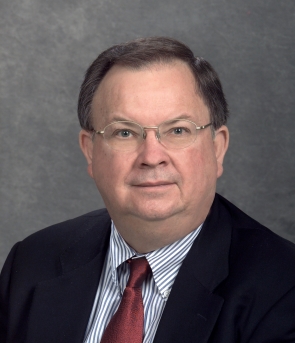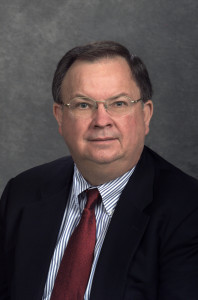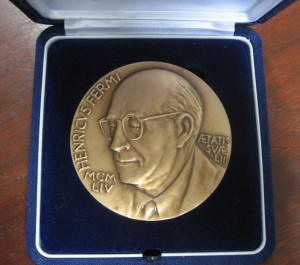Charles (Chuck) Shank, who served as Berkeley Lab’s director from 1989 through 2004, has been named by President Obama as one of two recipients of the Enrico Fermi Award, one of the federal government’s oldest and most prestigious awards for scientific achievement. The other recipient is UCLA physicist Claudio Pellegrini, considered the “patriarch” of the Linac Coherent Light Source (LCLS) at the SLAC National Accelerator Laboratory. The Fermi Award carries an honorarium of $50,000, shared equally by the recipients, and a medal. The award is administered on behalf of the White House by the U.S. Department of Energy (DOE).
“Claudio Pellegrini and Chuck Shank have deeply impacted our science, our labs, and our facilities throughout their distinguished careers and, in doing so, have contributed greatly to sustained U.S. leadership in research and development,” said Secretary of Energy Ernest Moniz. “I congratulate them for their achievements and hope that the example they set will inspire future generations of scientists and engineers.”
“Chuck Shank is an outstanding scientist and remarkable leader in keeping with the very best of the Berkeley Lab tradition,” said Lab Director Paul Alivisatos. “He led many advancements in femtosecond spectroscopy and ultrafast phenomena, and served as a national leader in solid state science. As the Lab’s director, he helped make the Advanced Light Source a world-leading center for soft X-ray science, and, with the launching of the Molecular Foundry, he helped usher DOE into a new era of nanoscience and biotechnology. For his many contributions, he is most deserving of the Fermi Award and our sincere gratitude.”
The Fermi Award honors the memory of Nobel Laureate Enrico Fermi, the first scientist to achieve a nuclear chain reaction and a pioneer in the field of nuclear and particle physics. The award has been presented to outstanding scientists since 1956 in recognition of “distinguished achievement, leadership, and service related to all basic and applied research, science, and technology” supported by DOE and its programs.
Shank, 71, was cited for “the seminal development of ultrafast lasers and their application in many areas of scientific research, for visionary leadership of national scientific and engineering research communities, and for exemplary service supporting the National Laboratory complex.”
Shank became Berkeley Lab’s fifth director in September of 1989 following a distinguished 20-year career at AT&T Bell Laboratories, where he made his mark as a pioneer in femtosecond laser spectroscopy and the study of ultrafast events, and where he invented the distributed feedback laser, a component in fiber optic communications.
During his tenure as the longest serving director of Berkeley Lab other than the Lab’s founder, Ernest O. Lawrence, the Laboratory’s annual budget more than doubled and the workforce grew to approximately 4,000. He presided over the construction of the Advanced Light Source, weathered its rocky adolescence, and helped manage its successful upgrade from a premier source of low-energy x-rays to a premier source of high-energy x-rays as well. He saw ground broken for the Molecular Foundry, and set the stage for bringing to the Lab the National Energy Research Scientific Computing Center (NERSC), and lead the creation of the Joint Genome Institute (JGI). He also championed the Supernova Cosmology Project, which led to the Nobel Prize-winning discovery of the “dark energy” that accelerates the expansion of the universe.
Under Shank’s watch, Berkeley Lab also participated in the discoveries of the top quark and neutrino mass, completed the Time Projection Chamber for the Relativistic Heavy Ion Collider and the front-end system for the Spallation Neutron Source, and finally began reclaiming the valuable land occupied by the long-defunct Bevatron.
When Shank announced he was stepping down as Berkeley Lab’s director, he expressed pride in what was accomplished under his 15 years of leadership.
“The opportunity to work with outstanding people in science at Berkeley Lab is unparalleled,” he said. “Through our work as a DOE Office of Science laboratory, we have made a great difference for the nation, opening new questions about energy in the universe, sequencing the human genome, developing nanoscience as a national endeavor, and achieving scientific discoveries through advanced computing. These advancements would not be possible without the dedicated support from the staff of the Laboratory, the University of California, and DOE.”
While director of Berkeley Lab, Shank held a unique triple appointment as a professor at the University of California, Berkeley in the departments of physics, chemistry and electrical engineering and computer sciences. UC Berkeley was Shank’s alma mater. He graduated summa cum laude from there in 1965 and went on to receive his M.S. and Ph.D degrees in 1969. In addition to his status as Director emeritus of Berkeley Lab, Shank is also currently a Senior Fellow with the Howard Hughes Medical Institute.
Additional Information
For more about the Fermi Award go here
To read the DO news release announcing the award go here
###
Lawrence Berkeley National Laboratory addresses the world’s most urgent scientific challenges by advancing sustainable energy, protecting human health, creating new materials, and revealing the origin and fate of the universe. Founded in 1931, Berkeley Lab’s scientific expertise has been recognized with 13 Nobel prizes. The University of California manages Berkeley Lab for the U.S. Department of Energy’s Office of Science. For more, visit www.lbl.gov.
DOE’s Office of Science is the single largest supporter of basic research in the physical sciences in the United States, and is working to address some of the most pressing challenges of our time. For more information, please visit the Office of Science website at science.energy.gov/.


